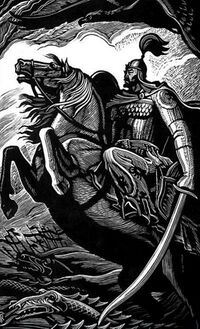Burania: Difference between revisions
m (→History: Added painting) |
mNo edit summary |
||
| Line 7: | Line 7: | ||
|population = | |population = | ||
|density = | |density = | ||
|demonym = | |demonym = Buran | ||
|countries = | |countries = | ||
|list_countries = | |list_countries = | ||
|dependencies = | |dependencies = | ||
|unrecognized = | |unrecognized = | ||
|languages = [[List_of_Spoken_Languages_on_Eurth| | |languages = [[List_of_Spoken_Languages_on_Eurth|Old Buranic]] | ||
|time = | |time = | ||
|internet = | |internet = | ||
Revision as of 12:32, 22 January 2020
 | |
| Demonym | Buran |
|---|---|
| Languages | Old Buranic |
| Largest cities | |
The region of Burania is a subcontinent in northeast Europa with colder climates.
Etymology
The name Burania derives from Bureas or Boreas (Βορέας, also Βορρᾶς), the Aroman god of the cold north wind and the bringer of winter.
Geography
Burania is home to several nations.
History

The clans of Buran came from the rugged, inhospitable north known today as Burania. As the Aroman Empire flourished further south, the Buranic people live in small settlements, without central government or coinage. In Aroman discourse, the words Buran and Buranic could designate a certain mentality. Buranic people were typically depicted as being very strong, with a violent temper to match. Their nomadic lifestyle was contrasted to the urbanized agricultural civilisation of Aroma. Historically, two related yet divergent cultures are distinguished: the coastal and interior Buranic peoples.
Along the Buranic coasts there lived seafaring cultures, of which the Vaarians and Aloorians are the most notable. In peaceful times these Buranic sailors spread far from Burania, gaining control of trade routes throughout Europa, building outposts as far as the Orient. As the Aroman Empire expanded north, some Buranians served in their new neighbors’ armies and brought home Aroman maritime technology. Competing chieftains quickly refined the new ships to be even more efficient. When not at war, the vessels were used to transport goods and make trade journeys.
When the Aroman Empire collapsed in the 5th century, their trade partners took a heavy economic blow, leveling the playing field a bit for the Buranians. As the region revived, new and vigorous trade routes extended into and through Burania. The wealth that flowed along these routes helped create a new, more prosperous and powerful class of Buranians, whose members competed constantly with each other over trade routes and territory. Thanks to their inventiveness in the face of difficult terrain and weak economies, the Buranians sailed west, settled the North Adlantic and explored the Alharun coast.
During times of scarcity, they became mercenaries and pirates, frequently attacking ships along the Occidental coast. Zenith of the pirates' power was under the Volscian triumvirate. Most of their attacks were focused on trade lines and unprotected convoys, relying on ambush and surprise. The Buranic pirates attacked in large numbers, trying to steal enemy ships using underhanded tactics. Or they disguised themselves as a ship in distress, waiting for their prey to approach.
The Buranic interior has long been home to nomadic steppe cultures living on the East-Europan plain. They domesticated the horse around 3200 BCE, leading to a more mobile lifestyle. These steppe tribes often appear in history as invaders of the Occident and Orient.
- WIP: (Pseudo-Anglo-Germano-Russo-Fennoscandian cultures)
Culture
The Curse of Buran is a belief that Buranic people have been under the influence of a malicious spell for many centuries. The "curse" manifests itself as pessimism, inner strife, and several historic misfortunes. The curse is also blamed for causing many personal troubles. Examples of this curse include:
- Defeat against the Aromans at the Battle of Cryophobae in 279 CE
- Loss of Vanarambaion to the Aroman successor states in 699
- Buranic Spring of 2018 was crushed by Volscian military, leading to severe reprisals and mass exodus of many Europans.
See also
References
This template may be deleted.
